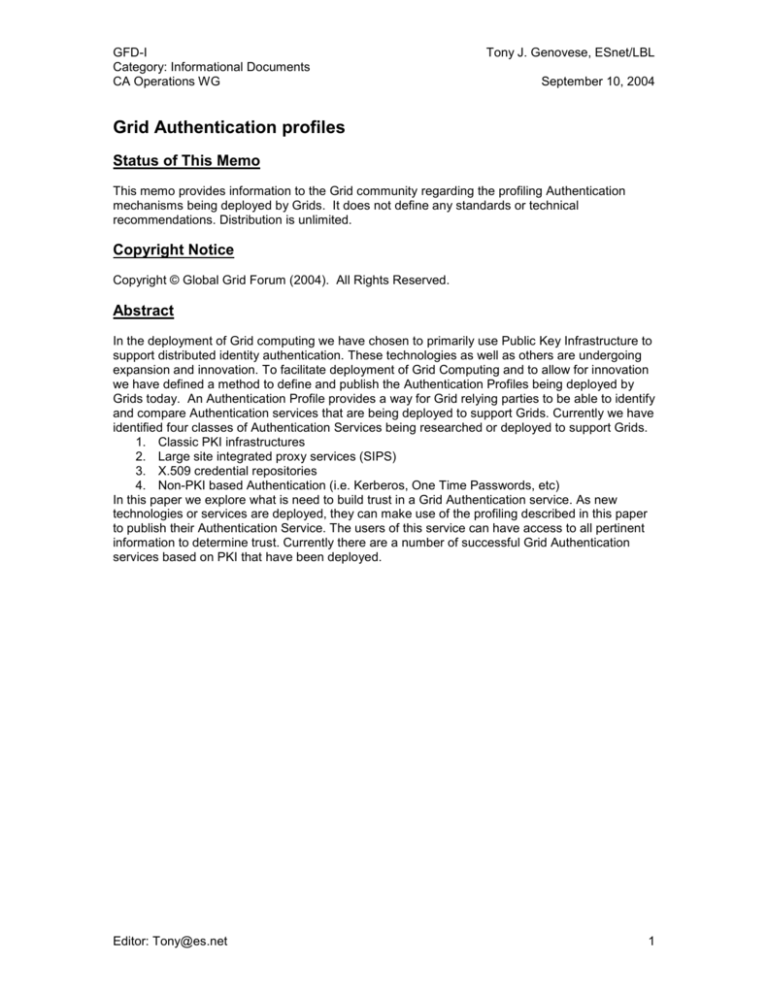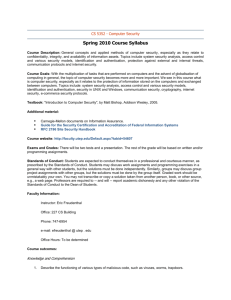
GFD-I
Category: Informational Documents
CA Operations WG
Tony J. Genovese, ESnet/LBL
September 10, 2004
Grid Authentication profiles
Status of This Memo
This memo provides information to the Grid community regarding the profiling Authentication
mechanisms being deployed by Grids. It does not define any standards or technical
recommendations. Distribution is unlimited.
Copyright Notice
Copyright © Global Grid Forum (2004). All Rights Reserved.
Abstract
In the deployment of Grid computing we have chosen to primarily use Public Key Infrastructure to
support distributed identity authentication. These technologies as well as others are undergoing
expansion and innovation. To facilitate deployment of Grid Computing and to allow for innovation
we have defined a method to define and publish the Authentication Profiles being deployed by
Grids today. An Authentication Profile provides a way for Grid relying parties to be able to identify
and compare Authentication services that are being deployed to support Grids. Currently we have
identified four classes of Authentication Services being researched or deployed to support Grids.
1. Classic PKI infrastructures
2. Large site integrated proxy services (SIPS)
3. X.509 credential repositories
4. Non-PKI based Authentication (i.e. Kerberos, One Time Passwords, etc)
In this paper we explore what is need to build trust in a Grid Authentication service. As new
technologies or services are deployed, they can make use of the profiling described in this paper
to publish their Authentication Service. The users of this service can have access to all pertinent
information to determine trust. Currently there are a number of successful Grid Authentication
services based on PKI that have been deployed.
Editor: Tony@es.net
1
GFD-I
Category: Informational Documents
CA Operations WG
Tony J. Genovese, ESnet/LBL
September 10, 2004
Table of Contents
1.
2.
Introduction ........................................................................................................................... 3
Authentication Service profile ............................................................................................... 3
2.1
What needs to be in an Authentication profile? ................................................................ 3
2.2
Minimum federation document .......................................................................................... 3
3.
Authentication service publication requirements .................................................................. 5
4.
Example Authentication service profiles ............................................................................... 5
Intellectual Property Statement ....................................................................................................... 5
Full Copyright Notice ....................................................................................................................... 5
References ...................................................................................................................................... 6
Editor: Tony@es.net
2
CFD-I
5/15/2004
1. Introduction
As we deploy authentication mechanisms in support of Computing Grids around the world we
need to provide the relying parties a way to evaluate these services. Currently the most prevalent
solutions for authentication used by Grids are based on PKI. This is not to say that other methods
will not be developed. This paper is to address how to identify and publish these Authentication
services for review by the relying parties that have to trust the method of identity proofing.
To facilitate deployment of Grid Computing and to allow for innovation we have defined a method
to define and publish the various authentication profiles being deployed by Grids today. An
Authentication Profile is designed to provide all the information a Grid relying party needs to be
able to identify and compare an Authentication service. Currently we have identified four classes
of Authentication Services being researched or deployed to support Grids.
1. Classic PKI infrastructures
2. Large site integrated proxy services (SIPS)
3. X.509 credential repositories
4. Non-PKI based Authentication (i.e. Kerberos, One Time Passwords, etc)
In this paper we explore what is need to build trust in a Grid Authentication service. As new
technologies or services are deployed, they can make use of the profiling described in this paper
to publish their Authentication Service. The relying parties of this service can have access to all
pertinent information to be able to determine trust. Currently there are a number of successful
Grid Authentication services based on PKI that have been deployed.
2. Authentication Service profile
In the Grid today there are a number of authentication services being deployed in support of Grid
computing. The purpose of this document is to provide an outline for defining and publishing an
Authentication Service’s profile. The Authentication services in Grids are based primarily on PKI,
this does not preclude other technologies from being defined and deployed. The inclusion in this
document and the publishing of a profile does not imply a warranty or the appropriateness of a
published profile. The decision to trust the published authentication service can only be made by
a relying party.
2.1
What needs to be in an Authentication profile?
For an authentication service to be trusted by relying partners a level of trust has to be
established and maintained. The relying parities are concerned with controlling access to their
resources by participants that may not be local or even a member of their community. To facilitate
global access, but maintain local control, the Grid community has split the Authentication and
Authorization processes. The Grid community has a number of Authentication Service providers
around the world, which provide high quality identity tokens for use by relying parties. The
Authorization step is completely left to the control of the relying party and this paper will not
address Authorization issues. To build trust in their Authentication services the community has
been providing the following basic services:
1. A governing board to manage the Authentication service
2. Set of membership and operational requirements
3. A publishing process for operational information that relying parties can trust.
2.2
Minimum federation document
This section covers an outline for the controlling document of an Authentication federation. It sets
up the structure and responsibilities of its members. In PKI based Authentication Federations,
RFC 2527 and its related documents can be used to define the operational and policies needed
to manage the Federation [RFC2527]. The US government has produced a guide for use by its
agencies to set up a X.509 based authentication [FBCA]. In addition to these documents the GGF
has produced guides to facilitate management of the federation.
1. Policy Management Charter
Tony@es.net
Helm@es.net
3
CFD-I
5/15/2004
a. This document provides guidelines to establish and manage the governing
board of the Federation
2. Global Grid Forum Certificate Poliyc model
a. This document can be used by PKI based Authentication Services to define the
policy and procedures used by the service
In non-PKI based Authentication Services there are no controlling documents. The following
section outlines what needs to be in an Authentication Federation charter.
2.2.1 General Federation Document outline
The following outline describes the main issues each federation should address in its chartering
document. This can be one or more documents, but all of the following sections should be
addressed.
1. Federation definition
a. Describe who the federation is and what its mission is. Also, which community
will be served by the federation.
b. The federation consists of the following members: Identify members, this should
also be published.
2. General Architecture
a. Describe the system architecture used to build the Authentication Service.
3. Identity
a. The federation must describe how identity is managed and communicated in the
federation.
b. Each member must define Identity vetting rules, what each member does to
prove the identity of the user identified as part of organization.
c. How a person or system is removed from the federation.
4. Operational requirements
a. QOS: 24/7 support or not, Trouble ticket reporting, Information request, and
general customer support. Require contact information, problem
reporting/resolution procedures.
5. Site security
a. For each member describe the: Software, network, server and physical security
at the site of the member. Each member to provide what they are doing - could
centralize each member’s information in an appendix.
b. Also describe: procedural controls, personnel security controls. Life cycle for
security controls - How do you update/change security controls and keep the
community informed?
6. Publication and Repository responsibilities
a. What information each must publish and maintain.
7. Liability
a. What are you liable for or NOT.
8. Financial Responsibilities
a. How do you pay for the service?
9. Audits
a. Do you audit each member for compliance to your requirements or do you trust
each site? Self audits or member audits are open to external audits by members
only...
10. Privacy, confidentiality
a. What are your privacy rules, IP policies, etc
11. Compromise and Disaster recover.
a. How do you handle exposed shared secrets or other compromised secrets?
12. Federation Administration
a. Change procedures for this federation document
b. Do you need a Policy or Federation Board for managing the federation?
c. How does a member join the federation?
d. How does a member leave the federation?
Tony@es.net
Helm@es.net
4
CFD-I
5/15/2004
e. How do you exchange information with each member in a secure manner?
3. Authentication service publication requirements
Each successful Grid Authentication service has a well know publishing point for information used
by the relying parties. There is no single publishing point that relying parties can go to find a Grid
Authentication Service. Some of the information that relying parties will need in a Grid
authentication service is:
1.
2.
3.
4.
Contact for the Federation Administration
Access to published documents of the Authentication service.
For PKI based systems a trusted independent source for trust anchors.
Contact for reporting problems or requesting customer assistance.
A common publishing point for Grid Authentication Services would facilitate Relying parties
locating the needed information. It is recommended for Grid Authentication services that the
above information be published in a GGF Informational doc and published by the GGF. This will
provide a common publishing location for Grid Authentication providers.
4. Example Authentication service profiles
Maybe do this as an appendix… Add EU, DOEGrids and AP as examples of Classic PKI profiles.
We could use FNAL as a SIPS… We can add NERSC, possible credential store.
Intellectual Property Statement
The GGF takes no position regarding the validity or scope of any intellectual property or other
rights that might be claimed to pertain to the implementation or use of the technology described in
this document or the extent to which any license under such rights might or might not be
available; neither does it represent that it has made any effort to identify any such rights. Copies
of claims of rights made available for publication and any assurances of licenses to be made
available, or the result of an attempt made to obtain a general license or permission for the use of
such proprietary rights by implementers or users of this specification can be obtained from the
GGF Secretariat.
The GGF invites any interested party to bring to its attention any copyrights, patents or patent
applications, or other proprietary rights which may cover technology that may be required to
practice this recommendation. Please address the information to the GGF Executive Director.
Full Copyright Notice
Copyright (C) Global Grid Forum (date). All Rights Reserved.
This document and translations of it may be copied and furnished to others, and derivative works
that comment on or otherwise explain it or assist in its implementation may be prepared, copied,
published and distributed, in whole or in part, without restriction of any kind, provided that the
above copyright notice and this paragraph are included on all such copies and derivative works.
However, this document itself may not be modified in any way, such as by removing the copyright
notice or references to the GGF or other organizations, except as needed for the purpose of
developing Grid Recommendations in which case the procedures for copyrights defined in the
GGF Document process must be followed, or as required to translate it into languages other than
English.
The limited permissions granted above are perpetual and will not be revoked by the GGF or its
successors or assigns.
Tony@es.net
Helm@es.net
5
CFD-I
5/15/2004
This document and the information contained herein is provided on an "AS IS" basis and THE
GLOBAL GRID FORUM DISCLAIMS ALL WARRANTIES, EXPRESS OR IMPLIED, INCLUDING
BUT NOT LIMITED TO ANY WARRANTY THAT THE USE OF THE INFORMATION HEREIN
WILL NOT INFRINGE ANY RIGHTS OR ANY IMPLIED WARRANTIES OF MERCHANTABILITY
OR FITNESS FOR A PARTICULAR PURPOSE."
References
[FBCA] - X.509 Certificate Policy For The Federal Bridge Certification Authority (FBCA), Version
1.0, 18 December 1999
[RFC2527] - S. Chokani and W. Ford, Internet X.509 Infrastructure Certificate Policy and
Certification Practices Framework, RFC 2527, March 1999
Tony@es.net
Helm@es.net
6







